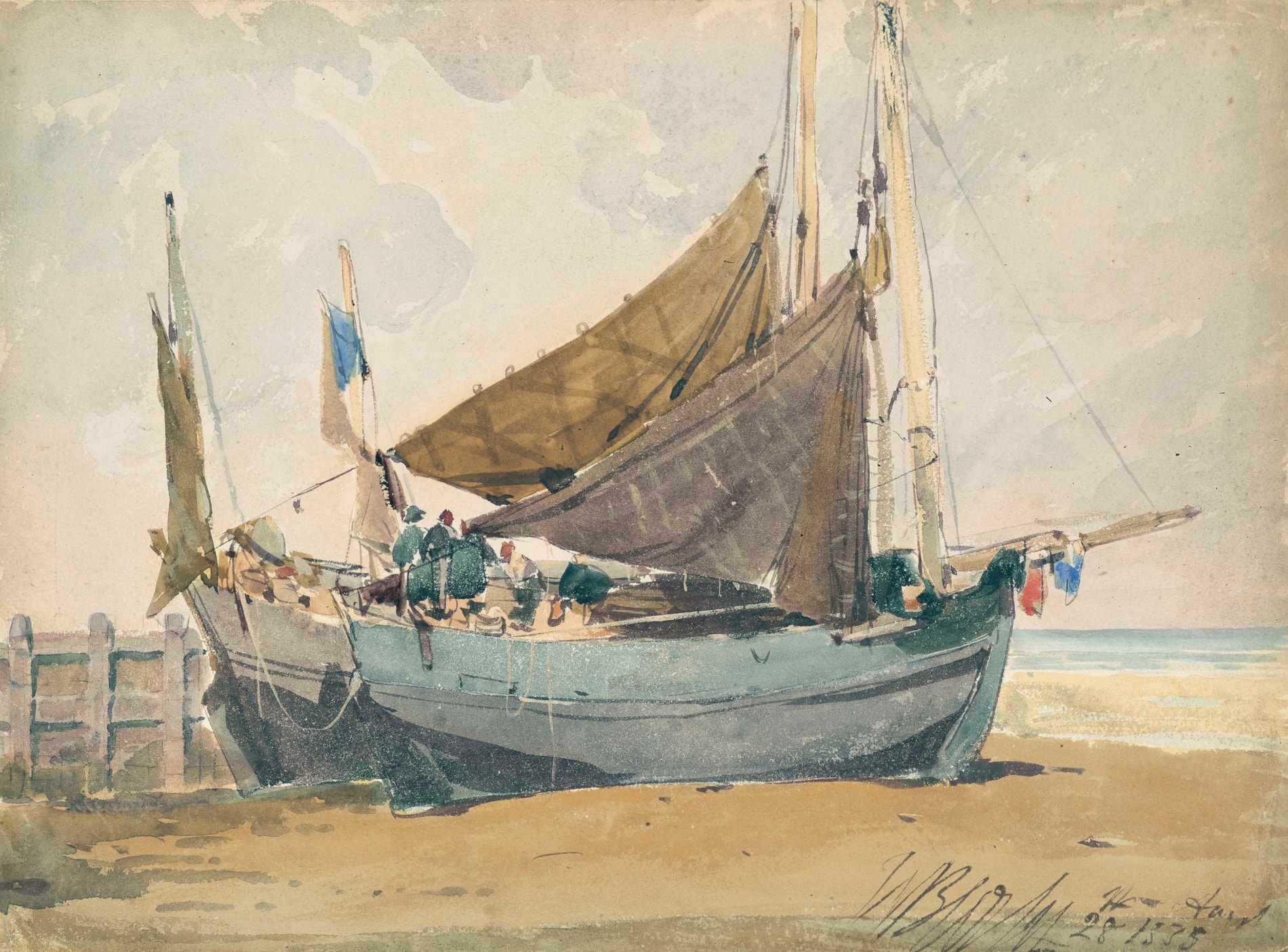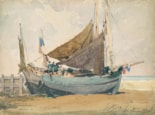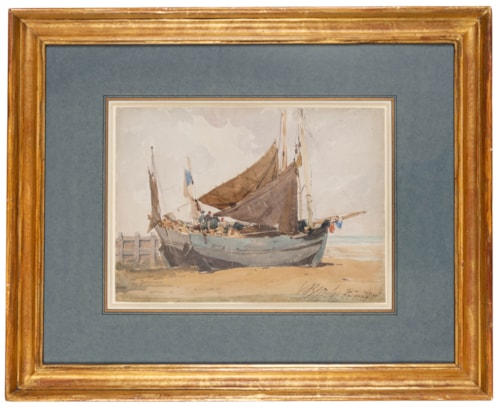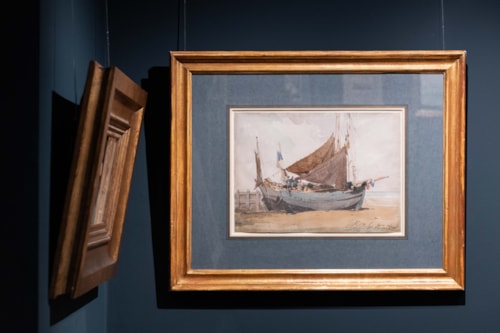William Roxby BEVERLEY
(Richmond 1811 - Hampstead 1889)
Fishing Boats on a Beach
Watercolour over a pencil underdrawing.
Signed and dated WBeverley [?] Augt. / 28 1835 at the lower right.
258 x 358 mm. (10 1/8 x 14 1/8 in.)
Signed and dated WBeverley [?] Augt. / 28 1835 at the lower right.
258 x 358 mm. (10 1/8 x 14 1/8 in.)
An early work, the present sheet is a fine example of Beverley’s lively watercolour sketches. In one of the first critical reappraisals of the artist’s oeuvre, published in 1921, Frank Emanuel noted that ‘there are numbers of charming little compositions and studies of boats and shipping, of which he had the completest practical knowledge, down to the smallest detail. Indeed, his knowledge of shipping was equal to that of any of the specialists in marine work...His drawing of the subtly curving lines of hulls, his delineation of spars and rigging, is absolutely faultless, and put in with a line unrivalled for certainty and purity.’
Similarly, a later writer opined that ‘Beverley was primarily a marine artist and his best works, I think, are his watercolours of coastal scenes, with boats either on the beach or off-shore. He did many such works in the early morning or at sunset and was masterly at depicting the sun just peeping through the dawn clouds…His draughtsmanship was first class. A close examination of some of his fishing boats, for example, shows what Martin Hardie described as a “structure of crisp and finely descriptive drawing”; the hulls, masts and rigging are put in with an accurate, confident line…Technically, too, his boats are good enough to withstand the scrutiny of any sea-going man.’
As the same author also notes, ‘A close look at some of Beverley’s best watercolours reveals a fluent, limpid style producing that luminosity and atmosphere that one finds also in paintings by Bonington, Holland or Callow. He was clearly influenced by Bonington and confidently used the same dragged brushwork technique which allows either the paper or the underlying wash to break through…So good was he at this that it has been suggested that some works attributed to the great man are more likely to have been done by Beverley.’
The scene depicted here is likely to be found in one of the fishing communities in the Northeast coast of England, where Beverley made several sketching tours.
Similarly, a later writer opined that ‘Beverley was primarily a marine artist and his best works, I think, are his watercolours of coastal scenes, with boats either on the beach or off-shore. He did many such works in the early morning or at sunset and was masterly at depicting the sun just peeping through the dawn clouds…His draughtsmanship was first class. A close examination of some of his fishing boats, for example, shows what Martin Hardie described as a “structure of crisp and finely descriptive drawing”; the hulls, masts and rigging are put in with an accurate, confident line…Technically, too, his boats are good enough to withstand the scrutiny of any sea-going man.’
As the same author also notes, ‘A close look at some of Beverley’s best watercolours reveals a fluent, limpid style producing that luminosity and atmosphere that one finds also in paintings by Bonington, Holland or Callow. He was clearly influenced by Bonington and confidently used the same dragged brushwork technique which allows either the paper or the underlying wash to break through…So good was he at this that it has been suggested that some works attributed to the great man are more likely to have been done by Beverley.’
The scene depicted here is likely to be found in one of the fishing communities in the Northeast coast of England, where Beverley made several sketching tours.
The son and grandson of actors and theatre managers, William Roxby Beverley began his career as a painter of scenery for the theatre and continued to work in this field throughout his life. Indeed, his reputation was established by his renown as a scene painter, and in particular his skill in rendering atmospheric effects. (An obituary published in the Daily Telegraph in 1889 described Beverley as the ‘long acknowledged chief and doyen of English scenic artists’, although the author also noted his ‘noble water-colours done in leisure hours.’) Beverley began to produce landscape watercolours under the influence of Clarkson Stanfield, also a former scene painter, whom he joined on sketching tours, as well as Richard Parkes Bonington. Although Beverley began exhibiting his marine watercolours from 1831 onwards, he continued to make his living as both a scene painter at the Theatre Royal in Manchester and, occasionally, as an actor. By 1846 he had settled in London, and was engaged as scenic director at several theatres, notably at the Lyceum, Covent Garden and Drury Lane. By comparison with many of his fellow artists, however, Beverley produced relatively few watercolours, since he was kept busy by the demands on his time as a theatrical painter and scenographer. Nevertheless, as one early critic had noted, ‘Beverley painted water-colour pictures of rare and delicate beauty, works which alone should suffice to win for him a place in the front rank among our masters of water-colour art.’
Beverley worked for his entire career in England and Scotland, although he is known to have visited France and Switzerland. He was particularly fond of coastal scenes and depictions of such port towns and fishing communities as Scarborough, Eastbourne, Hastings and Sunderland, and also painted views in London, the upper Thames valley and the Lake District. In many of his watercolours, there is a particular interest in skies and atmospheric effects; a legacy of his training as a scene painter. Beverley regularly exhibited his landscape watercolours, which were almost always of English coastal scenes, at the Royal Academy between 1865 and 1880. He also showed his work at such commercial galleries as the Dudley Gallery and charged up to £400 for some of his finished watercolours. Watercolours by Beverley are today in the collections of the Victoria Art Gallery in Bath, the National Galleries of Scotland in Edinburgh, the Leeds Art Gallery in Leeds, Harrow School and the Victoria and Albert Museum in London, and elsewhere.
Beverley worked for his entire career in England and Scotland, although he is known to have visited France and Switzerland. He was particularly fond of coastal scenes and depictions of such port towns and fishing communities as Scarborough, Eastbourne, Hastings and Sunderland, and also painted views in London, the upper Thames valley and the Lake District. In many of his watercolours, there is a particular interest in skies and atmospheric effects; a legacy of his training as a scene painter. Beverley regularly exhibited his landscape watercolours, which were almost always of English coastal scenes, at the Royal Academy between 1865 and 1880. He also showed his work at such commercial galleries as the Dudley Gallery and charged up to £400 for some of his finished watercolours. Watercolours by Beverley are today in the collections of the Victoria Art Gallery in Bath, the National Galleries of Scotland in Edinburgh, the Leeds Art Gallery in Leeds, Harrow School and the Victoria and Albert Museum in London, and elsewhere.
Provenance
Michael Ingram, Driffield Manor, Driffield, Gloucestershire
His posthumous sale, London, Sotheby’s, 6 June 2007, part of lot 248
Private collection, England.
His posthumous sale, London, Sotheby’s, 6 June 2007, part of lot 248
Private collection, England.






